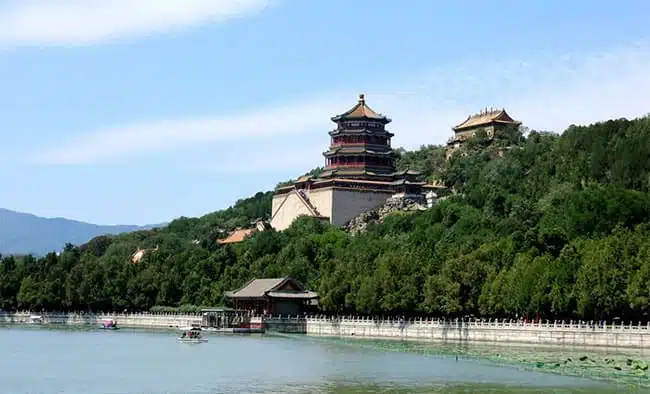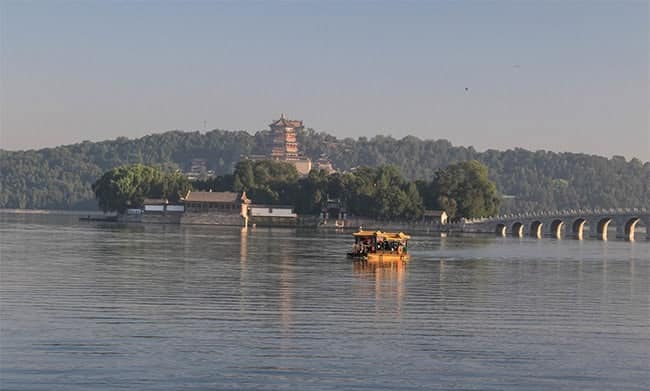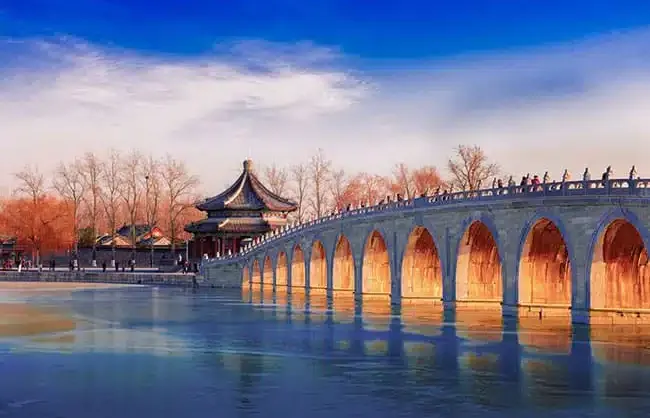Located in Beijing Haidian District, the Summer Palace in Beijing (aka Yiheyuan) boasts China’s largest and best-preserved imperial garden, covering a significantly large area of about 3.009 square kilometers. The garden was built from 1750 to 1764 during the Qing Dynasty and was originally known as Qingyi Garden. Its design was inspired by the West Lake in Hangzhou, as well as the hills and water landscape features of traditional Jiangnan gardens. The entire garden is centered around Kunming Lake and Longevity Hill and is dotted with elegant pavilions, corridors, bridges, and rock formations.
Thanks to its remarkable structures and landscapes, the garden has been listed as a UNESCO World Heritage site in 1998. For many tourists from around the world, it has become a must-visit attraction on any Beijing tour.

Fast Facts of Beijing Summer Palace
- Chinese name: 颐和园(yí hé yuán)
- Location:At 19 Xinjian Gongmen Road, Haidian District, in the western suburbs of Beijing
- Area: 3.009Square Kilometers (about 293 hectares )
- Opening hours: 6:00-20:00 from April to October; 6:30-17:00 from November to March
- Visiting time needed: 5-7 hours, vary according to different travel paces and routes.
- Regular tickets: CNY 30 per person ( Apr. to Oct.), CNY20 per person (Nov. to Mar.).
- Combo tickets:(include Dehe Garden, Summer Palace Museum, Tower of Buddhist Incense, and Suzhou Street ) CNY 60 per person (Apr. – Oct.), CNY 50 per person (Nov. – Mar.)
- Best time to visit:Spring and autumn
- Why visit: A UNESCO World Heritage site and a masterpiece of Chinese landscape garden design; blends the elegance of Jiangnan gardens and the grandeur of northern landscapes; rich historical buildings; various architectural masterpieces; family-friendly environment and activities; Kunming Lake boat ride.

History of Summer Palace
Initial Construction
Originally named Qingyi Garden, the Summer Palace was initially constructed in 1750 during the reign of Emperor Qianlong in the Qing Dynasty. The emperor gathered skilled artisans from across the country and took 15 years to complete this project to celebrate his mother’s birthday.
Because of his fondness for the misty beauty of Jiangnan, the garden’s design drew on the feel of West Lake in Hangzhou but also emphasized local water and hill landscape adaptations.
Destruction and Reconstruction, Renamed as Summer Palace
During the Second Opium War, the Qingyi Garden was destroyed by the British and French allied forces in 1860.
Then, in 1886, Empress Cixi oversaw the reconstruction of the garden and renamed it the Summer Palace (Yiheyuan in Chinese). However, in 1900, it suffered another significant damage by the Eight-Nation Alliance, leaving it once again in ruins.
Fortunately, restoration work began in the following year, allowing this royal garden restored to its former glory.
Opened to the Public & Listed as a UNESCO World Heritage Site
After 1928, Yiheyuan Summer Palace was transformed into a truly public garden.
After 1949, multiple restorations and reconstructions were undertaken, gradually restoring many key attractions to their original grandeur.
In 1989, the garden was listed as a UNESCO World Heritage site.
Today, thanks to the addition of essential visitor facilities and the establishment of frequent public transportation routes, the garden has become a convenient and popular attraction in Beijing.
Beijing Summer Palace Layout
Longevity Hill and Kunming Lake form the basic framework of Yiheyuan, with water covering about three-quarters of the total area. Its general layout follows the traditional Chinese garden design of “front palace, back garden”.
Inside the Yiheyuan Garden is a wide array of attractions that can be roughly divided into three main areas: the Front Mountain and Lake Area, the Palace Area, and the Back Mountain and Lake Area.
The Front Hill and Lake Scenic Area is formed by Kunming Lake and Longevity Hill, covering over 80% of the entire garden. Main attractions in this area include the Six Bridges on the West Dike, Seventeen-Arch Bridge, Tower of Buddhist Incense, the 700-meter Long Corridor, and the symbolic Marble Boat.
The Palace Area is at the easternmost part of the Summer Palace, serving as the imperial residence and administrative center. Main halls and palaces such as the Hall of Benevolence and Longevity (仁寿殿), the Hall of Happiness and Longevity (乐寿堂), and the Hall of Jade Ripples (玉澜堂) are all scattered in this area.
The Back Hill and Lake Scenic Area is located on the northern slope of Longevity Hill.
Main Attractions in the Summer Palace
Tower of Buddhist Incense (佛香阁)
Towering on the top of Longevity Hill, this iconic building is the highest point in the Summer Palace and offers a great spot to enjoy the panoramic view of Kunming Lake and the surrounding scenery. The octagonal tower itself is eye-catching, featuring yellow glazed tiles. Inside, it houses Buddha statues, showcasing the deep cultural heritage of Buddhism.
Seventeen-Arch Bridge (十七孔桥)
Spanning Kunming Lake for about 150 meters, the bridge connects Nanhu Island and the East Bank with its distinctive 17 archways. From afar, the bridge looks like a long rainbow above the water. A top highlight here is the 544 unique , intricately crafted stone lions on the elegant arches.

The Long Corridor (长廊)
Stretching 728 meters, the Long Corridor is the longest-covered walkway in the world. The corridor includes 273 sections, with over 14,000 exquisite paintings of different themes painted on the roof.
The Marble Boat (石舫)
This is a marble structure shaped like a real boat, located on the shore of Kunming Lake. The two upper decks are made of wood, and are adorned with exquisite carvings.
The Garden of Virtue and Harmony (德和园)
Once the residence of Empress Cixi, the garden features the Grand Theater, which is the place for the Empress and the Emperor to watch performances and rest. The theater is a three-story building, boasting the biggest and best-preserved wooden stage in China.
Hall of Jade Ripples (玉澜堂)
The hall is a traditional courtyard-style building featuring a main hall flanked by the east and west wing pavilions. Emperor Guangxu was imprisoned here after the failure of the “Hundred Days’ Reform”.
Hall of Happiness and Longevity (乐寿堂)
The hall is between the Hall of Benevolence and Longevity and the Long Corridor, which once served as the living quarters of Empress Cixi. It is the most luxurious building in the Summer Palace, housing Cixi’s bedchamber and Emperor Guangxu’s study.
Hall of Benevolence and Longevity (仁寿殿)
It is the main venue for Empress Cixi and Emperor Guangxu to handle state affairs during their residence at the Summer Palace. The building features a solemn elegant appearance and lavish decorations.
Suzhou Street (苏州街)
A commercial street that was designed to resemble the famous Shantang Street in Suzhou, Suzhou Street was originally home to a variety of shops and tea houses. In 1860, the street was destroyed by fire, and the current street was rebuilt on the original site, with its original charm remaining.
Garden of Harmonious Interests (谐趣园)
One of the most beautiful areas in the Summer Palace, the Garden of Harmonious Interests features over 20 distinct attractions, such as rear river, rear lake, and the Stone Buddha Temple.
Recommended Travel Routes
There are various routes to tour the garden, and below is a general guidance:
Most attractions in the garden are concentrated in the northern section. So, it’s recommended to enter through the North Palace Gate. A small path heading west is at the base of the hill. Take the small path to the west, and explore the attractions in the northern section from west to east until you reach the Seventeen-Arch Bridge. Then, you can exit the park from the New Palace Gate if your time is limited.
With more time, you can take a Kunming Lake boat ride from South Lake Island to the West Causeway, then walk back toward the North Palace Gate. This way, you can cover most attractions in the garden.
When is the Best Time to Visit Yiheyuan
The Best time to visit the Summer Palace is spring (April and May) and autumn (September to October) when the weather is pleasant, and the air is crisp. March to May is the blooming season of various flowers and October is the best time to enjoy osmanthus flowers. As a royal summer retreat, the park is also delightful to visit in summer and will reward you with stunning lotus flowers.
If travel to Beijing during these periods, a Summer Palace visit will reward you with much fun.
Tips:
- Visitors had better avoid the official holidays in China, because many Chinese citizens choose to travel on official holidays. As a result, most Chinese tourist attractions are overcrowded and traffic jams are quite common.
- To escape the crowds, you’d better enter the park around 9 AM, when the number of visitors is relatively low.
Essential Travel Tips
- How to Get to: Take Metro Line 4 and get off at either Xiyuan Station or North Palace Gate Station. Frequent buses are also available for reaching.
- Avoid visiting on Mondays: Many attractions within the park are closed on Mondays.
- Highly recommended to take a boat: Taking a boat to enjoy the scenery from the water is highly recommended. Both electric and sightseeing boats are offered from mid-March to mid-November.
- Wear comfortable shoes: It will take about 5-8 hours to explore the entire garden and need a lot of walking.
- Ticketing: Separate tickets are required for the Tower of Buddhist Incense, the Garden of Virtue and Harmony, and the Summer Palace Museum. Or, you can buy the combo tickets with these sites included.
- Food and water: Food vendors are not evenly distributed within the park, so bring some snacks and water.
Best Beijing Tours including the Summer Palace
- 4 Days Beijing Tour
- 2 Days Beijing Stopover Tour
- 3 Days Beijing Package Tour: City Highlights & Great Wall
Attractions Nearby
-
- Beijing Zoo: About 10 km away.
- Old Summer Palace: Aka Yuanmingyuan, about 3 km away
- Xiangshan Park: About 10 km away, best known for the stunning red leaves in autumn.









